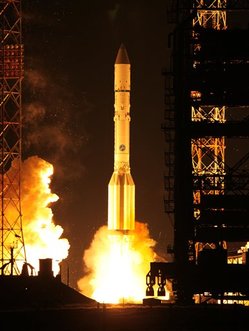Russian Rocket Fails To Reach Target Orbit

A Russian booster rocket on Tuesday failed to place two communications satellites into a designated orbit, officials said, marring the prestige of the nation's space program a day after NASA landed a robotic vehicle on Mars.
Russia's Roscosmos space agency said the Proton-M rocket was launched just before midnight Monday from the Russian-leased Baikonur cosmodrome in Kazakhstan. The booster's first stages worked fine, but the upper stage intended to give the final push to the satellites switched off earlier than expected, it said.
The engine's malfunction stranded the Russian Express MD-2 and Indonesia's Telkom-3 satellites in a low orbit that would make it impossible for space officials to recover them, Russian news agencies reported. The Indonesian satellite was Russian-made.
The failure comes a day after NASA managed to land a roving laboratory the size of a compact car on Mars after an eight-month, 352-million-mile (566-million-kilometer) journey.
A Russian robotic probe designed to study a moon of Mars got stranded in Earth orbit after its launch last November and eventually came crashing down in January.
A few months before, a Soyuz booster rocket similar to those serving the International Space Station failed, prompting officials to ponder over plans to leave the space outpost unmanned. Russian space officials eventually tracked down the reason, saying it was caused by an "accidental" manufacturing flaws and the Soyuz launches resumed.
Those mishaps followed other failures. Russia lost three navigation satellites in December 2010, then a military satellite in February 2011 and a telecommunications satellite in August of that year.
Officials blamed the botched launches on the post-Soviet industrial meltdown that stymied modernization of once-proud space program, which put the first satellite in orbit and sent the first human into space. Despite a steady increase of funding thanks to windfall oil revenues, Russia's space industries continue to rely on obsolete equipment and aging workforce, and production standards have degraded.



